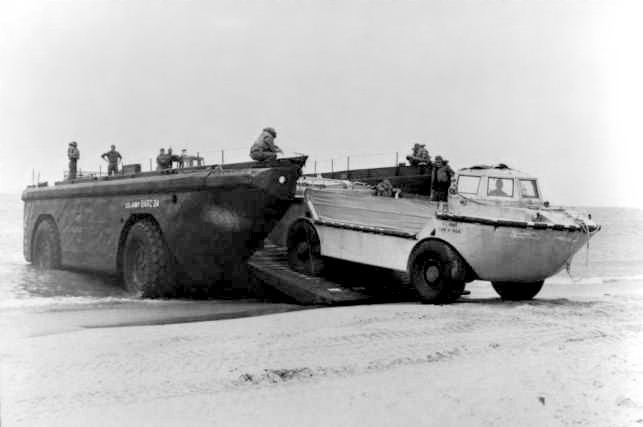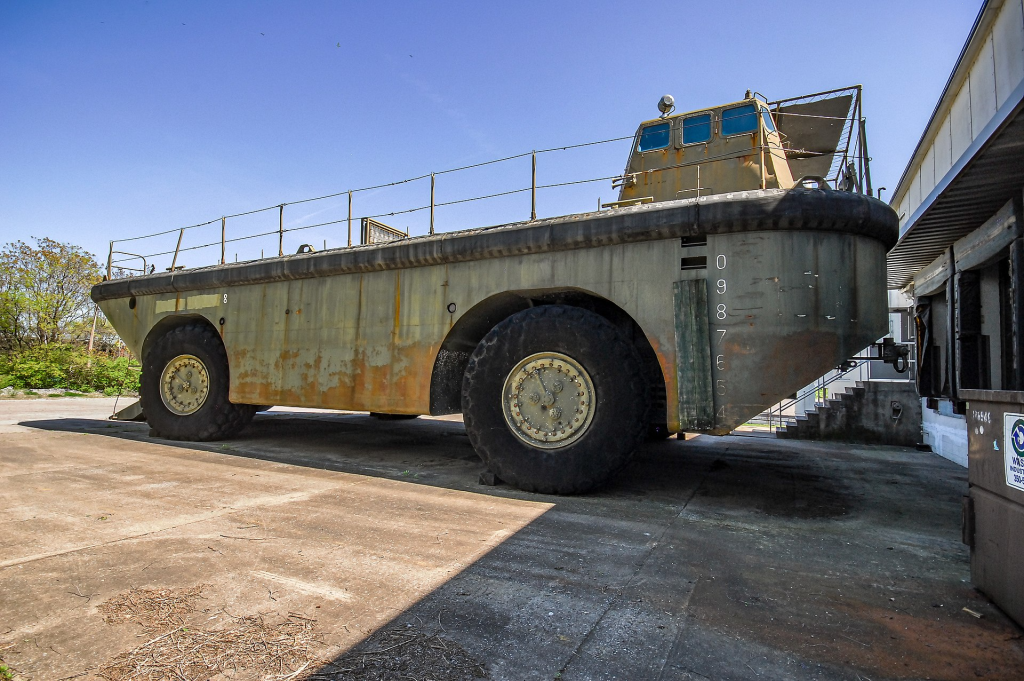The LARC-LX (Lighter, Amphibious Resupply, Cargo, 60 ton), initially known as BARC (Barge, Amphibious Resupply, Cargo), is an amphibious cargo vehicle with a welded steel hull.

It was capable of transporting up to 100 tons of cargo or 200 passengers, although a typical load usually consisted of 60 tons of cargo or 120 people. The LARC-LX was powered by four 265 hp (198 kW) GMC diesel engines located within the hull’s sides, each powering a single wheel for land movement.
In water, two of these engines were paired to operate each of the two 1.2 m (47 in) diameter propellers, enabling aquatic propulsion.
On land, the vehicle could reach speeds of up to 20 mph (32 km/h), while in water, its maximum speed was around 7.5 mph (12.1 km/h). The operator’s station was situated in a small cab positioned on the port side at the rear of the vehicle.
Development and Early History
In the 1950s, the geopolitical climate was dominated by the Cold War, a period marked by rapid advancements in military technology and a heightened focus on global military capabilities.
The United States, in particular, recognized the need for a versatile and robust logistics solution that could efficiently transport cargo from sea to shore, especially in regions lacking established port facilities.
 It is powered by four 265 horsepower GMC diesel engines.
It is powered by four 265 horsepower GMC diesel engines.
This need was driven by the U.S. military’s strategy of maintaining a global presence and the ability to respond quickly to international incidents.
Against this backdrop, the U.S. Army Transportation Corps identified the requirement for a large, amphibious vehicle capable of carrying substantial loads. The aim was to develop a vehicle that could seamlessly transition between sea and land operations, thereby overcoming the limitations of traditional cargo transport methods.
In response to this requirement, the Borg Warner Corporation, a company known for its industrial prowess, was awarded the contract to develop what would become the LARC-LX.
The developmental phase posed several significant challenges. The vehicle not only had to be sufficiently large to carry heavy and bulky cargo, but it also needed to be adaptable to various types of terrain, including sandy beaches, marshes, and rough coastal waters.
Moreover, it had to achieve this without compromising on speed and efficiency. The engineering ingenuity behind the LARC-LX was therefore focused on creating a design that was as functional in water as it was on land.
 An M60A2 tank is driven off LARC 60
An M60A2 tank is driven off LARC 60
The first prototype of the LARC-LX was completed in 1952, marking a significant milestone in amphibious vehicle technology. The design featured a large, box-like hull with a flat bottom, ideal for water buoyancy, while its large, robust wheeled configuration enabled effective land mobility. The project was an ambitious endeavor, reflecting the era’s forward-thinking approach to military logistics.
LARC-LX Design and Features
At its core, the LARC-LX was engineered to seamlessly transition between aquatic and terrestrial environments, a capability that set it apart from conventional vehicles of its time.
Measuring an impressive 62 feet in length, the LARC-LX was a behemoth, dwarfing most other military vehicles. Its design centered around a box-like, flat-bottomed hull, which was essential for buoyancy and stability in water.
This hull design enabled the LARC-LX to float and maneuver with ease in aquatic environments, a critical feature for amphibious operations. The vehicle’s size was not just for show; it was purpose-built to carry loads of up to 60 tons, making it one of the largest and most capable amphibious cargo vehicles ever constructed.
 The operator’s cab is located on the port side at the rear end of the vehicle.
The operator’s cab is located on the port side at the rear end of the vehicle.
Powered by four diesel engines, the LARC-LX was as powerful as it was large. These engines provided the necessary thrust for both land and water operations. In water, the vehicle was propelled by two 1,200-horsepower propellers, providing the thrust needed to navigate coastal and open-water conditions.
Without Established Ports
On land, the LARC-LX relied on its four large rubber tires, each powered by its own engine, to traverse various terrains. This dual-mode propulsion system was a feat of engineering, allowing for smooth transitions between sea and shore.
The LARC-LX’s wheels were another notable feature. The large, low-pressure tires were designed to distribute the vehicle’s weight evenly, reducing ground pressure and enabling it to move across soft and uneven terrains, such as beaches and marshlands, without becoming bogged down.
This capability was particularly important for operations in areas without established ports or harbors, where conventional wheeled vehicles would struggle.
 The LARC-LX’s top speed on land is 20 mph (32 km/h).
The LARC-LX’s top speed on land is 20 mph (32 km/h).
Inside, the LARC-LX was equipped with a spacious cargo area, capable of accommodating a wide range of loads, from heavy equipment and vehicles to supplies and personnel.
The open cargo space allowed for easy loading and unloading, a critical factor in rapid military logistics.
Furthermore, the LARC-LX’s design included practical considerations for crew comfort and operational efficiency. Despite its primary function as a cargo carrier, the vehicle was equipped with necessary navigation and communication equipment, ensuring it could operate effectively as part of a larger military force.
Operational Use of the LARC-LX
During its service, the LARC-LX proved to be an invaluable asset, notably during the Vietnam War, where its unique capabilities were put to the test under challenging combat conditions.
In Vietnam, the LARC-LX’s primary role was to facilitate the transport of cargo from ships anchored offshore directly to the beaches, bypassing the need for deep-water ports and conventional unloading facilities. This capability was crucial in areas where infrastructure was either damaged or non-existent, a common scenario in the war-torn regions of Vietnam.
The LARC-LX’s ability to carry large loads, including heavy equipment such as tanks and artillery, as well as substantial quantities of supplies, made it essential for sustaining military operations.
Its versatility was further demonstrated in its capacity to transport troops, providing a critical link between sea and land forces.
Beyond its logistical applications, the LARC-LX also played a role in humanitarian missions. Its ability to navigate both water and rough terrain made it an ideal vehicle for delivering aid and supplies in remote or disaster-stricken areas.
Vietnam War
In scenarios where traditional transport methods were infeasible or too slow, the LARC-LX provided a swift and effective solution, underscoring its value beyond purely military operations.
 The heaviest of the series, the BARC, in Vietnam.
The heaviest of the series, the BARC, in Vietnam.
The LARC-LX’s deployment in the Vietnam War highlighted not only its operational capabilities but also its robustness and reliability in hostile environments. Operating in a theatre known for its challenging terrain and harsh conditions, the LARC-LX consistently performed its duties, proving its design and engineering were well-suited for the rigors of combat logistics.
After the Vietnam War, the use of the LARC-LX continued, although it gradually transitioned to more peacetime roles. Its post-war applications underscored its adaptability and the continued relevance of its amphibious capabilities.
Whether in military exercises, civilian construction projects, or humanitarian efforts, the LARC-LX remained a valuable tool for transporting heavy loads across challenging terrains.
LARC-LX Later Years and Retirement
As the years progressed, the LARC-LX began to witness a gradual decline in its active military use, transitioning into what can be described as its later years and eventual retirement.
This phase in the LARC-LX’s lifecycle was marked by technological advancements and a shift in military logistics strategies, which gradually reduced the reliance on this once-indispensable amphibious vehicle.
By the time the Cold War was drawing to a close, the strategic landscape of global military operations had evolved. Newer, more advanced amphibious vehicles and improved logistics systems were being introduced, offering enhanced capabilities and efficiencies.
These developments inevitably led to the LARC-LX being overshadowed by more modern technology. However, the phasing out of the LARC-LX from active military duty did not mark the end of its operational life.
In its post-military years, the LARC-LX found a new lease of life in various civilian roles. Its unique capabilities made it well-suited for a range of applications beyond the battlefield.
In Arctic research, for example, its ability to navigate both waterways and challenging land terrains proved invaluable.
The LARC-LX was also employed in private sector operations, particularly in industries that required the transportation of heavy equipment across complex environments, such as mining and construction.
Some LARC-LX vehicles also found their way into the hands of private collectors and enthusiasts, fascinated by their historical significance and unique engineering.
In these settings, the LARC-LX was often restored and preserved, serving as a tangible link to the past and a piece of living history.
The retirement of the LARC-LX from active military service did not diminish its legacy. Instead, it highlighted the vehicle’s versatility and enduring design.
It continued to demonstrate its utility in a variety of new contexts, proving that the ingenuity and innovation that went into its creation had lasting value.





